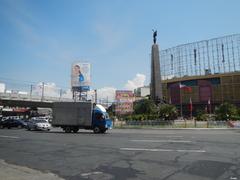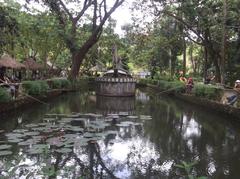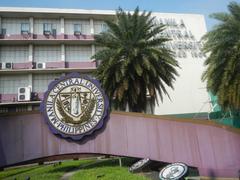
Discover the Wonders of Caloocan, Metro Manila, Philippines
Date: 14/08/2024
Start Your Adventure with a Bang
Welcome to Caloocan, a city where historical tales and modern-day vibrancy blend seamlessly into a tapestry of culture and adventure. Imagine walking the streets where heroes once trod, feeling the echoes of the Philippine Revolution in every corner. This bustling metropolis in Metro Manila isn’t just another city; it’s a living museum teeming with stories waiting to be uncovered. Caloocan’s roots stretch back to the Spanish colonial period, where it served as a significant battleground in the fight for independence. The iconic Bonifacio Monument stands as a testament to the city’s indomitable spirit, honoring Andres Bonifacio and the revolutionaries who changed the course of Philippine history (Crowdsourced Explorer).
But Caloocan is not just about its past. It’s a dynamic urban center that celebrates diversity, from its vibrant festivals to its rich culinary scene. With over 1.5 million residents, the city is a melting pot of cultures, religions, and traditions, making it a fascinating destination for any traveler (Discover the Philippines). Whether you’re a history buff, a food enthusiast, or an adventure seeker, Caloocan offers a little something for everyone. So, buckle up and get ready to explore the hidden gems and local secrets that make Caloocan a must-visit destination!
What You’ll Find in This Guide
- Historical Roots
- Early Beginnings and Spanish Colonial Period
- The Philippine Revolution
- Post-Revolution and American Period
- Modern Development and Urbanization
- Cultural and Historical Landmarks
- Visitor Tips
- Cultural Diversity
- Discover Caloocan: A Tapestry of History and Culture
- Historical Significance and Cultural Heritage
- Demographics and Population
- Religious Diversity
- Festivals and Celebrations
- Cuisine and Culinary Diversity
Historical Roots of Caloocan
Early Beginnings and Spanish Colonial Period
Caloocan’s history is deeply intertwined with the broader narrative of the Philippines, particularly during the Spanish colonial period. Originally, Caloocan was the area where the old town of Tondo and Tambobong (now Malabon) met, located along the shores of Dagat-Dagatan, a crescent-shaped inland lagoon to the west. The settlement along the shore was called “Aromahan,” or “Espina” to the Spaniards, and was separated from Manila Bay by a narrow ridge from Tondo towards an opening in Kinabutasan leading to the sea (Wikipedia).
Caloocan became a municipality when it was separated from Tondo in 1815. Its original territory extended to the foothills of Marikina, San Mateo, and Montalban to the east; Tinajeros, Tanza, and Tala rivers to the north; San Juan del Monte, San Francisco del Monte, Sampalok, Santa Cruz, and Tondo in the south; and Dagat-dagatan and Aromahan to the west (Wikipedia). The local government building was set up on the relatively well-settled portion just above Libis Espina. The old Aromahan chapel was finally abandoned, and a new church was built facing the municipal hall.
The Philippine Revolution
Caloocan played a pivotal role in the Philippine Revolution against Spanish rule. The Cry of Balintawak, a historical event that marked the beginning of the revolution, occurred in the vicinity of what is now Caloocan. This event, which took place on August 23, 1896, was a declaration of Filipino nationalism and resistance against colonial oppression (Medium).
The significance of Caloocan in the fight for independence is commemorated by various historical markers and monuments across the city. The Bonifacio Monument, located in Monumento Circle, stands as a tribute to Andres Bonifacio, a key figure in the revolution. This iconic structure serves as a reminder of the city’s role in shaping the destiny of the Philippines (Facts.net).
Post-Revolution and American Period
Following the Philippine Revolution, Caloocan continued to be a significant site during the Philippine-American War. The city was a battleground for Filipino forces resisting American colonization. The Katipunan Shrine in Caloocan commemorates the founding of the Katipunan, a revolutionary organization during the Philippine Revolution (Facts.net).
Modern Development and Urbanization
From its beginnings as a humble barrio of the town of Tondo, Caloocan is situated in a ‘libis’ (lowland) known as ‘Libis Espina’ (lowland thorns) or ‘Aromahan’. According to opinions and even beliefs, the name ‘Caloocan’ originated either from the Tagalog word ‘look’ meaning bay or ‘sulok’ meaning corner. Caloocan might have meant ‘nasa sulok’ or in the corner since the city is located where the ends of the old town of Tondo and Tambobong meet (Caloocan City Government).
At the end of the 18th century, the fishermen of Aromahan climbed the hills to open homesteads in Caloocan. Here, the land was free of thorny plants that infested the banks/shorelines, and although the hill was naturally stony, some form of agriculture was possible, and fishermen became farmers (Wikipedia).
Cultural and Historical Landmarks
Caloocan is home to several significant historical landmarks that offer a glimpse into its rich past. The Bonifacio Monument, created by National Artist Guillermo Tolentino, is a prominent landmark that commemorates the heroism of Andres Bonifacio and the Filipino revolutionaries (The Crazy Tourist). The monument features sculptures of Filipino soldiers fiercely pointing swords towards their opposition and waving a flag in the air, symbolizing the Filipino people’s resilience and bravery.
Another notable landmark is the Katipunan Shrine, which honors the founding of the Katipunan, a secret revolutionary society that played a crucial role in the Philippine Revolution (Facts.net). The shrine serves as a reminder of the city’s significant contribution to the country’s fight for independence.
Visitor Tips
For tourists interested in exploring Caloocan’s historical roots, several key sites should be on the itinerary:
-
Bonifacio Monument: Located in Monumento Circle, this iconic structure is a must-visit for history enthusiasts. The monument is easily accessible via the LRT-1 Monumento Station (The Crazy Tourist).
-
Katipunan Shrine: This shrine offers a deeper understanding of the revolutionary activities that took place in Caloocan. It is located near the Bonifacio Monument, making it convenient to visit both sites in one trip (Facts.net).
-
San Roque Cathedral: As the city’s first Catholic Church, it holds cultural and religious significance. The church’s intricate statues and grand ceiling make it a sight to behold (Jetjotter).
-
La Mesa Watershed: For nature enthusiasts, the La Mesa Watershed offers a serene escape from the urban hustle. It is a protected area that serves as the primary source of drinking water in Metro Manila (Facts.net).
-
Chinese Cemetery: This cemetery features a red brick archway and the Chong Hock Tong Temple, providing a unique cultural experience for visitors. The cemetery houses memorials and monuments that pay tribute to Chinese Martyrs and earthquake victims (Jetjotter).
Practical Information
When in Caloocan, remember to greet locals with a friendly ‘Kamusta!’ and always remove your shoes before entering someone’s home.
Need to get around? Hop on a jeepney and experience Caloocan like a true local. Just make sure to have small bills ready!
-
Transportation: Caloocan is well-connected by various modes of transportation, including buses, jeepneys, and the LRT-1. The railway system is recommended for its convenience and efficiency in navigating the city (The Crazy Tourist).
-
Accommodation: For those planning to stay in Caloocan, the Gubat sa Ciudad Resort offers a variety of fun activities and amenities, including treehouses, playhouses, water slides, and sports complexes (Travel Triangle).
-
Local Cuisine: Don’t miss out on trying the famous “Caloocan Longganisa” and the refreshing “Kalookan Halo-Halo.” For a diverse culinary experience, visit eateries like Mister Kabab for Middle Eastern dishes and Angle’s Town Café for local favorites (Jetjotter).
By exploring these historical and cultural landmarks, visitors can gain a deeper appreciation of Caloocan’s rich heritage and its significant role in shaping the history of the Philippines.
Cultural Diversity in Caloocan, Metro Manila, Philippines
Discover Caloocan: A Tapestry of History and Culture
Imagine a place where history whispers through the streets, where every corner has a story to tell. Welcome to Caloocan City, a vibrant urban hub in Metro Manila with a rich cultural heritage. Known for its pivotal role in the Philippine Revolution, Caloocan is more than just a city—it’s a living museum that captures the spirit of the Filipino people.
Historical Significance and Cultural Heritage
Caloocan’s streets have seen the footsteps of heroes. During the Spanish colonization period, it was a hotbed of revolutionary fervor. The Bonifacio Monument stands tall, commemorating Andres Bonifacio, the fearless leader of the Katipunan. This landmark isn’t just a statue; it’s a symbol of the city’s indomitable spirit and a reminder of the fight for independence (Crowdsourced Explorer).
Demographics and Population
With over 1.5 million residents, Caloocan is a bustling metropolis teeming with life. It’s split into North and South Caloocan, each with its own unique flavor. Picture a melting pot where various ethnicities and cultures blend, creating a vibrant and diverse community (Discover the Philippines).
Religious Diversity
Caloocan’s religious landscape is a mosaic of faiths. From grand Roman Catholic churches to the century-old Thai To Taoist Temple, the city is a testament to religious harmony. Imagine the scent of incense wafting through the air as you explore this three-story temple, a sanctuary for Chinese and Chinese-Filipino residents (Discover the Philippines).
Festivals and Celebrations
Caloocan knows how to throw a party! One of the most anticipated events is Bonifacio Day on November 30th. Picture parades, cultural performances, and the city coming alive to celebrate its historical roots. It’s a day when history and festivity intertwine (Crowdsourced Explorer).
Cuisine and Culinary Diversity
Prepare your taste buds for an adventure! Caloocan’s culinary scene is a feast for the senses. From street vendors selling local delicacies to chic cafes offering international cuisine, there’s something to satisfy every palate.
Discover the Charms of Caloocan, Metro Manila, Philippines
Welcome to Caloocan: A City of Surprises
Hold onto your hats, folks! Caloocan is more than just a stopover in Metro Manila; it’s a treasure trove of history, culture, and fun waiting to be uncovered. From the monumental to the whimsical, this city has a little something for everyone. So, buckle up and let’s dive into the heart of Caloocan!
Historical Landmarks
Bonifacio Monument: A Pillar of Patriotism
Standing tall and proud, the Bonifacio Monument isn’t just a statue; it’s a beacon of Filipino courage. Designed by national artist Guillermo Tolentino and unveiled in 1933, this iconic landmark honors Andres Bonifacio, the fiery revolutionary leader. Snap a selfie here and soak in the vibe of sheer bravery. Don’t forget to stroll around the park and mingle with locals—this is where history meets everyday life. (source)
La Loma Cemetery: A Walk Through Time
Fancy a stroll through history? La Loma Cemetery, one of the oldest in Metro Manila, is like an open-air museum with its ornate mausoleums and tombstones. Dating back to the Spanish colonial period, it’s a serene spot to reflect and imagine the stories behind those beautifully crafted memorials. History buffs, this one’s for you. (source)
Cultural and Recreational Activities
Gubat sa Ciudad Resort: Urban Jungle Adventure
Escape the concrete jungle and dive into a real one at Gubat sa Ciudad Resort. This family-friendly haven offers swimming pools, picnic spots, and even zip-lining! Designed to mimic a forest, it’s perfect for both relaxation and adventure. Feel the breeze as you zip through the trees or simply chill by the pool—choices, choices! (source)
Malabon Zoo and Aquarium: Animal Encounters
Just a hop away from Caloocan, the Malabon Zoo and Aquarium is a must-visit for animal lovers. Home to exotic birds, reptiles, and mammals, this privately-owned zoo is all about wildlife conservation. Get up close and personal with your favorite critters and learn about their habitats. It’s a fun, educational day out for the whole family. (source)
Shopping and Dining
SM City Grand Central: Retail Therapy Heaven
Need a shopping fix? SM City Grand Central has you covered. With a mix of local and international brands, a food court that’s a foodie’s dream, and a cinema complex, it’s a one-stop-shop for all things fun. Whether you’re hunting for bargains or just window shopping, this mall is a slice of retail paradise. (source)
Sangandaan Market: The Local Flavor
Dive into the hustle and bustle of Sangandaan Market, where you can find everything from fresh produce to local delicacies. It’s a sensory overload—in the best way possible. Chat with friendly vendors, taste some street food, and feel the pulse of Caloocan’s daily life. This is where the real magic happens. (source)
Parks and Green Spaces
Caloocan City North People’s Park: Urban Oasis
Looking for a breather? Caloocan City North People’s Park is your go-to spot. With landscaped gardens, walking paths, and playgrounds, it’s perfect for a family day out or a solo morning jog. It’s also a hub for community events, so you might just stumble upon a local festivity. (source)
Tala Leprosarium Park: History and Tranquility
Once a leprosarium during the American colonial period, Tala Leprosarium Park is now a peaceful public park surrounded by lush greenery. It’s a place of remembrance and tranquility, where history and nature blend seamlessly. Take a quiet walk and reflect on the stories of those who were treated here. (source)
Festivals and Events
Caloocan Cityhood Anniversary: A Celebration of Heritage
Every February 16th, Caloocan bursts into celebration to mark its cityhood anniversary. Expect parades, cultural performances, and sports competitions. It’s a time for the community to come together in a colorful display of heritage and pride. Visitors get a front-row seat to the festivities and a chance to join in the fun. (source)
Bonifacio Day: Honoring a Hero
On November 30th, the city honors its native son, Andres Bonifacio, with ceremonies at the Bonifacio Monument. Wreath-laying, speeches, and cultural performances make this a day of reflection and pride for Caloocan residents. Tourists can gain a deeper understanding of Bonifacio’s legacy and the city’s historical significance. (source)
Practical Tips for Visitors
Getting Around: Navigate Like a Pro
Caloocan is well-connected by jeepneys, buses, and the LRT Line 1. The Monumento station is your gateway to the rest of Metro Manila. For a more comfortable ride, try ride-hailing services like Grab. Trust us, you’ll be zipping aroundin no time! (source)
Safety and Etiquette: Blend In and Enjoy
Caloocan is generally safe, but keep an eye on your belongings and avoid dimly lit areas at night. Respect local customs—dress modestly, especially at religious sites, and engage with locals respectfully. A friendly smile and a few Tagalog phrases can go a long way in making your visit more enjoyable. (source)
Unlock Caloocan’s Secrets with Audiala
Ready to uncover Caloocan’s hidden gems? Download Audiala, the ultimate tour guide app, and let it lead you to the city’s best-kept secrets. From audio guides to interactive challenges, Audiala makes exploring Caloocan a breeze. Don’t miss out—download now and start your adventure!
By diving into these attractions and activities, visitors can experience the rich tapestry of Caloocan—where history, culture, and modernity weave together seamlessly.
Your Next Steps with Audiala
As you wrap up your journey through Caloocan, it’s clear that this city is more than just a historical landmark; it’s a vibrant community that embodies the spirit of the Filipino people. From the towering Bonifacio Monument to the tranquil La Mesa Watershed, Caloocan offers a unique blend of history, culture, and modernity (Facts.net). The city’s diverse religious landscape, bustling markets, and lively festivals provide a rich cultural experience that’s hard to match (Discover the Philippines).
Whether you’re exploring the intricate statues of San Roque Cathedral or enjoying a local delicacy at Sangandaan Market, Caloocan invites you to dive deep into its rich heritage and contemporary charm. Remember, every corner of this city has a story to tell, and with Audiala, you can uncover these tales at your own pace. Download Audiala, your ultimate tour guide app, and let it lead you through the hidden gems and historical landmarks that make Caloocan truly unforgettable. Embark on your adventure today and experience the city like a true local!
Where to Learn More
- Historical Roots of Caloocan. Wikipedia. Retrieved from Wikipedia.
- Caloocan: A Dynamic Tapestry of Heritage, Challenges, and Progress. Medium. Retrieved from Medium.
- 48 Facts About Caloocan. Facts.net. Retrieved from Facts.net.
- History of Caloocan. Caloocan City Government. Retrieved from Caloocan City Government.
- 15 Best Things to Do in Caloocan. The Crazy Tourist. Retrieved from The Crazy Tourist.
- Exploring Caloocan: History, Landmarks, and Recreation. Jetjotter. Retrieved from Jetjotter.
- Explore Caloocan City: A Vibrant Metro Manila Destination. Jetjotter. Retrieved from Jetjotter.
- Discover Caloocan City: Visitor’s Guide. Discover the Philippines. Retrieved from Discover the Philippines.
- Bonifacio Monument. Philippine Country. Retrieved from Philippine Country.
- La Loma Cemetery: A Walk Through Time. Spot.ph. Retrieved from Spot.ph.
- Gubat sa Ciudad Resort. Tripadvisor. Retrieved from Tripadvisor.
- Malabon Zoo and Aquarium. Tripadvisor. Retrieved from Tripadvisor.
- SM City Grand Central. SM Prime. Retrieved from SM Prime.
- Sangandaan Market. Spot.ph. Retrieved from Spot.ph.
- Caloocan City North People’s Park. Tripadvisor. Retrieved from Tripadvisor.
- Tala Leprosarium Park. Spot.ph. Retrieved from Spot.ph.
- Caloocan Cityhood Anniversary. Caloocan City Government. Retrieved from Caloocan City Government.
- Bonifacio Day. Official Gazette. Retrieved from Official Gazette.
- Getting Around Caloocan. LRT 1. Retrieved from LRT 1.
- Health and Safety in Caloocan. Tripadvisor. Retrieved from Tripadvisor.
















